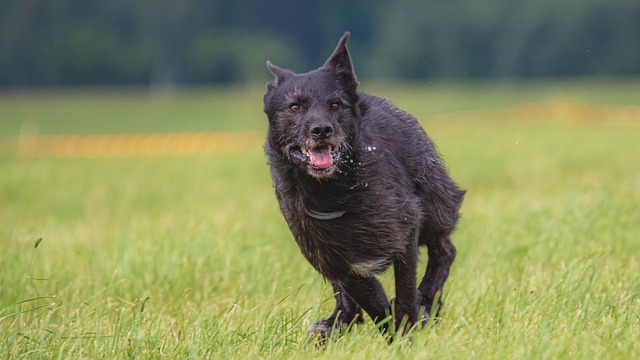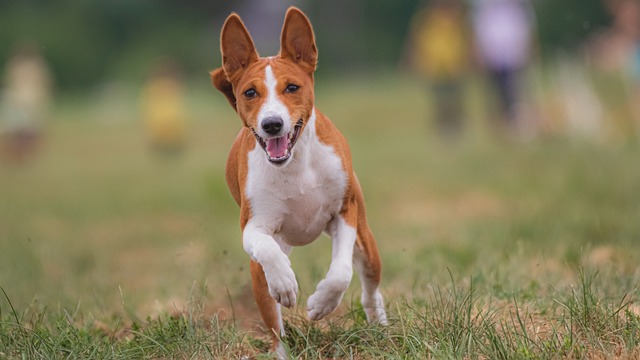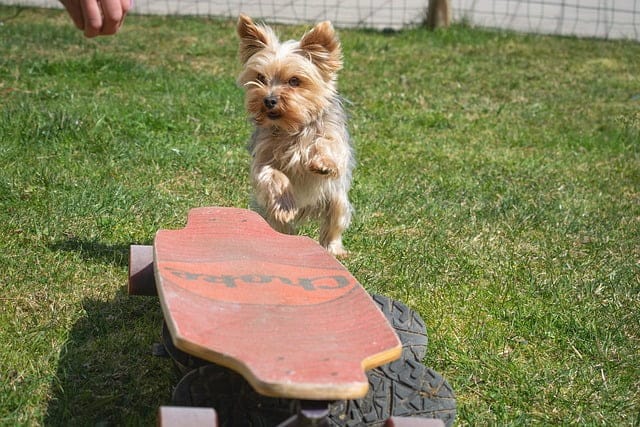Training Your Dog In A Nutshell

There are a great number of benefits and rewards that come from training your dog. The advice in this article will offer many tips and techniques associated with training your dog. This is productive time for both you and your dog.
Training is an ongoing process – your dog needs to be constantly reminded of the rules! People think that just because their dog has been trained once, that is all they need. Dogs, though, are like people in the way they fall into habits. This is why on-going training is important.
Try to view things from your dog’s eyes. Frustration can be easily acquired if your dog fails to learn simple things in a rapid manner. Don’t give up- think instead.Imagining things as they see things may give you a different perspective on training them.
If you encounter a dog with whom you are not acquainted, you should do so slowly and with the back of a hand outstretched. The dog will become familiar with your smell and recognize the scent in the future. When the dog becomes familiar with your smell, he will not fear you and will respond to your commands easier.
Your dog needs to be active lifestyle. Dogs can easily become bored easily. A bored dog without interest in what you’re doing is more difficult to train. Your dog will obey more relaxed and willing to listen if you keep them well exercised.Go for long walks and runs with your dog on a regular basis.
Be patient when training a dog. Patience is the best way to keep your dog from becoming confused and for you to remain calm. Understand that the proper training will come with time, so cut your dog some slack and let them learn.
Dogs can concentrate on one thing intensely and you will have the uncanny ability to have single-minded focus when something catches their attention. If you do it enough times, your dog will start to wait for your signals before focusing on something.
If your dog is jumping on you, grab his paws with your hands and gently squeeze them to deter his behavior. As long as you gently squeeze their paws, you won’t cause harm to your dog. Instead, you’ll just give them an comfortable feeling. Since it is so uncomfortable, they’ll avoid jumping on people.
Repetition is key to teaching a dog new command. It may take between 25 to 50 repetitions of the same command for your dog to learn it.
Maintain short training sessions. Since dogs do not have a long attention span, making sure training sessions are kept short ensures that your dog will not dread them. If you want to do anymore training, let the dog have a play break for stretching and relaxing before continuing with their training.
Try not to reinforce bad behaviors from your dog by accident.This means denying your dog with attention or treats for doing something you don’t want it to do. If the dog jumps at you, don’t encourage him by slipping him a morsel one night or allowing others to do so.
As you train your dog, be certain to gain his attention the same way every time. When calling your dog, use their name every time. Use your dog’s name to get his or her attention. Once you do this, tell your dog your command. Dogs tend to respond by name right away and they know that you want their attention.
Do not use a shock collars. They often do not work very well as they say they do and are far too expensive. They can cause your dog’s behavior too much.
Stick with positive reinforcement when it comes to dog training. Use positive language to reward the dog, as well as petting and small treats on occasion. Do not shout or strike the dog. Doing this will cause your dog to act out even more and lose respect for you. Be firm, positive and consistent, and you will get great results.
This lets them know you are serious and that they must obey. It also helps them understand the differences between a sharp punishing tone and a reprimand.
The first step in training a puppy is to make sure he knows his name. Simply start by calling his name as often as possible. Once he learns his name, you can encourage him to come to you when called. These are the commands your dog should learn before anything else. It’s important that the time spent with your puppy is quality time. Spend your time playing with your puppy. This way he will get to know you quicker and will begin to trust you faster. Once your puppy trusts you, it will be easier to train him.
Teaching a dog to walk correctly while on his leash is important. This helps keep both of you safe while taking walks.
Remember not to reward your dog for bad behavior when they do something negative. This teaches the dog that he is in control. For example, you should avoid offering a treat to the animal to stop it from barking.
Continue training throughout the dog’s entire life to make sure that its good behavior persists. You do not have to stop training your dog at the end of their puppy stage. By practicing positive reinforcement and proper discipline throughout your dog’s life, the negative attidue behavior will cease to appear.
When training your dog, it is important to remember to keep the training sessions relatively short. You should use at most 15 minutes for training. Any longer and the dog will become frustrated and will not respond correctly. After training make sure to play with your pet and show him a lot of praise.
Do not give your dog too many treats he gets in one day.
To make the most of your dog training efforts, stay consistent. One way to ensure everyone in your household uses the same commands is to create an easily accessible list of the commands used to train your dog. In addition, make sure that the behaviors of the dog are treated consistently. Good behaviors get rewarded; bad behaviors do not. When the people around the dog use different commands and responses, he may become confused and training could suffer.
A good tip is to make sure you are aware if other dogs are present when you’re taking your dog for a walk. You need to be well aware of any dogs may be aggressive.If you see a dog that seems to be unsociable or defensive, avoid that dog.
Make sure your dog has gotten its shots. If your dog suddenly regresses in training, take him to the vet to make sure there isn’t a health issue. Dogs are very adept at hiding pain and discomfort. Frequently, the only way you will know that a health problem exists is when you observe changes in behavior. For instance, aggression may signal pain, while regression concerning house training may be suggestive of urinary tract infections.
It may be difficult, but you must be patient when it comes to your dog. Your dog doesn’t understand your language and he is not a person. Your dog only picks up on gestures and the tone of voice you are acting a certain way. Remain calm and take several breaks if you’re getting frustrated often during the training sessions.
A “shake can” is very helpful in training your dog. Place a hand full of coins in any empty can, and then seal it up with tape. Shake the can if your dog misbehaves. The distraction alone is usually enough to stop your dog. Your dog will soon realize their behavior is unacceptable after a few shakes. You should only shake it one time, if done more than one time your dog will not respond to it any longer.
You can ensure that your dog and re-teaching it the tricks you’ve taught it. Quiz him on what he knows, even if you’re already sure he does.
Be sure to discourage unwanted behaviors at the moment they occur. Say “no” in a strong voice. Don’t raise your voice or strike your dog. Discourage incorrect behavior in the moment it happens. Dogs memories do not last that long. If you don’t correct the behavior immediately after it happens, your dog will not understand what you are doing.
If dog agility classes are the ultimate goal of your training, do some research before buying one. Most dogs can learn agility and join competitions, but some breeds are more competitive such as collies, Australian shepherds and Labs usually do best in these competitions.
If specific things trigger bad behavior in your pup, distract him while you are passing the temptation. Try distracting your dogs from other dogs while on your walks. This will create a positive association between the trigger and receiving attention or entertainment from you.
If your dog places the ball someplace else and you make the effort to pick it up, he thinks he is in charge. Your dog will understand his expectations if he must always bring the ball back to you every time.
Mental exercise is an vital part of your dog’s life. Dogs that do not chew a lot can have their senses stimulated with canine toys and puzzles. There is a variety of dog puzzle toys that will help your dog develop his full cognitive abilities.
Make sure that your dog gets checked out regularly. If your dog suddenly regresses in training, check up on his health. Dogs are very adept at hiding discomfort and discomfort. Behavioral changes may be the only way you will know if there is a deeper issue. For instance, aggression can be a sign of pain, and a sudden house training regression may indicate an infection in the urinary tract.
Make sure you are aware of any signs your dog shows you that he or she is uncomfortable with something. If your pooch is uneasy around new people or other animals, don’t push him. He is uneasy for a reason, and that should be respected. If you put too much pressure on your dog you might cause it to react violently.
Any introductions to new animals needs to be attempted very slowly. Before you even consider adopting a new pet, consider how it will affect the pets you already have. You should make sure your pets get along so that you can establish a good bond.
Keep the dog outside when you leave to prevent him from chewing on household items. If you cannot do this, then make rooms that have valuable items in them inaccessible.
Every dog is receptive to different types of training models. If your dog doesn’t respond well to treats, you must find some other type of reward that will act as an incentive. If treats work for you dog, that can be an effective reward in many different situations.
Never use treats as the only reward for good behavior. Dogs need food for survival, so reward them another way. Supplement treats with other forms of recognition, including verbal encouragement and physical affection.
Don’t ever get angry the training isn’t going well with your dog for poor responses during training. If your dog is not responding to training, then maybe you aren’t doing a good job.
Always speak positively when using your dog’s name. If you stay positive, you’ll find the dog will come when you call it. Therefore, you should never use your dog’s name in a negative manner.
There are many benefits to training your dog. If you take the advice of this article, and apply what you have learned, you will find that canine training can be fun. Enjoy spending time with your dog as you teach him that teamwork pays off.
Rewards and repetition are the two keys to making dog training pay off. You need to demonstrate proper behavior, then work with your dog over time and reward him when he does the right thing. That is how dogs are able to grasp tricks. Show your pet the right way through rewards and repetition.


